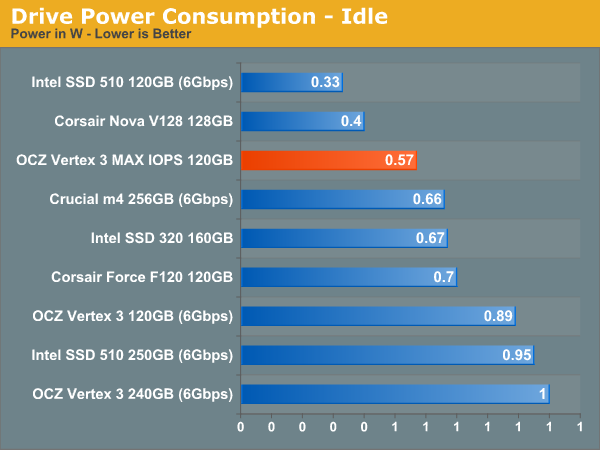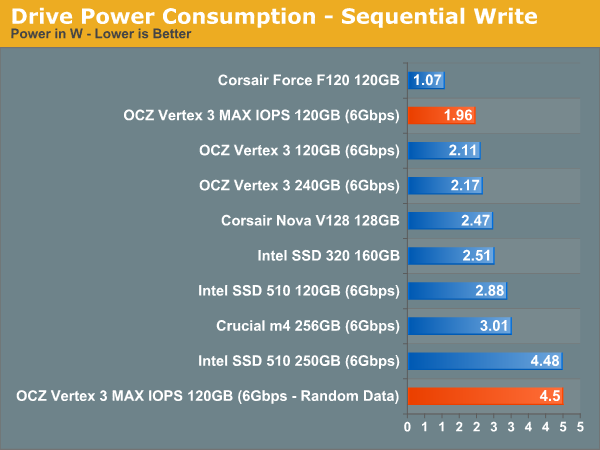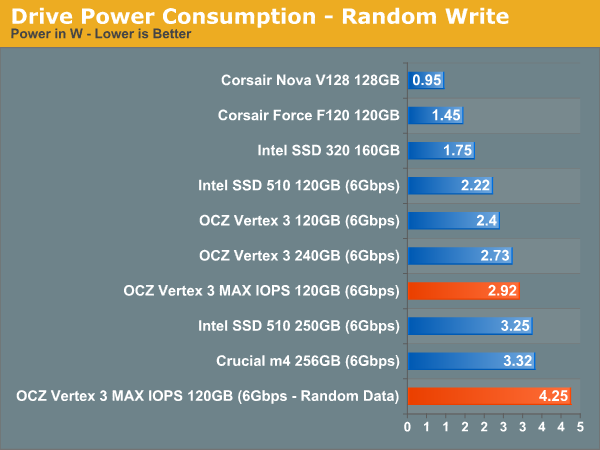OCZ Vertex 3 MAX IOPS & Patriot Wildfire SSDs Reviewed
by Anand Lal Shimpi on June 23, 2011 4:35 AM ESTTRIM Performance
In practice, SandForce based drives running a desktop workload do very well and typically boast an average write amplification below 1 (more writes to the device than actual writes to NAND). My personal SF-1200 drive had a write amplification of around 0.6 after several months of use. However if subjected to a workload composed entirely of incompressible writes (e.g. tons of compressed images, videos and music) you can back the controller into a corner.
To simulate this I filled the drive with incompressible data, ran a 4KB (100% LBA space, QD32) random write test with incompressible data for an hour, and then ran AS-SSD (another incompressible data test) to see how low performance could get:
| OCZ Vertex 3 240GB MAX IOPS - Resiliency - AS SSD Sequential Write Speed - 6Gbps | |||||
| Clean | After 1hr Torture | After TRIM | |||
| OCZ Vertex 3 MI 240GB | 247.9 MB/s | 50.1 MB/s | 160.6 MB/s | ||
I usually run this test for only 20 minutes but after seeing an unusually resilient performance by the 240GB drives I decided to extend the test period to a full 60 minutes. Performance does drop pretty far at that point, down to a meager 50MB/s. TRIMing the drive does restore some performance but not all. If you have a workload that uses a lot of incompressible data (e.g. JPGs, H.264 videos, highly random datasets etc...) then SandForce just isn't for you.
Power Consumption
The MAX IOPS drive does use significantly more power than the regular Vertex 3, particularly under heavy load with incompressible data. There are more NAND die firing in parallel which results in higher power consumption. For a notebook that's going to be on battery power most of the time, you may want to consider a standard SF-2281 with 25nm IMFT NAND.













112 Comments
View All Comments
DrBungle - Tuesday, August 2, 2011 - link
My config;Asus G73
Core i7 2630
8GB RAM
Shipped with 2 X 500GB 7200PRM HDDs
I pulled the OS drive and replaced it with a Vertex 3. I had stutter issues for the first couple days, that was corrected with 2.09 firmware.
Since then, I've had over 2 months of problem free computing. Large file transfers, extractions, transcodings and countless hours of Bad Company 2 (in preparation for BF3) with not ONE BSoD or even mild hiccup.
Am I the only person in the universe who really likes this drive?
It simply can't be that my notebook computer is somehow magically circumventing some critical flaw with this drive. The term "PEBCAK" comes to mind with a lot of the complaints I hear.
RTFM. (Read The Forums Man). If you want plug and play simplicity, stick with HDDs. Personally, I like a new challenge every now and then but my Vertex 3 certainly wasn't one of them.
umesh - Tuesday, February 28, 2012 - link
In the PC Mark Vantage tests, why is there no trace of the OCZ Vertex 3 240 GB Max IOPS drive at all? Was it not tested or what? Please enlighten me.